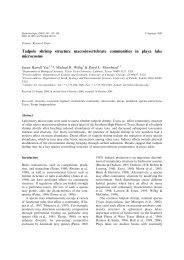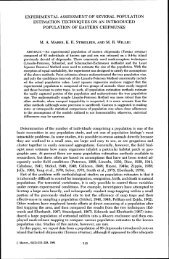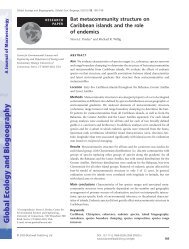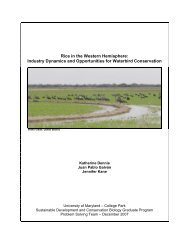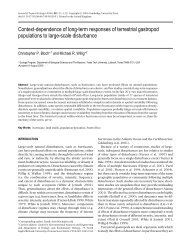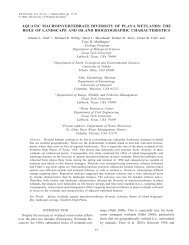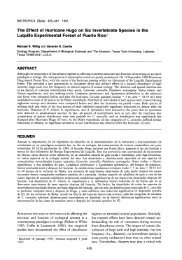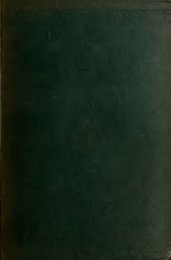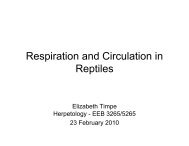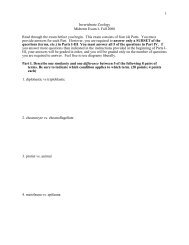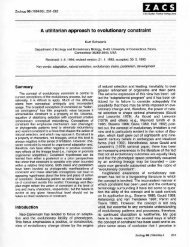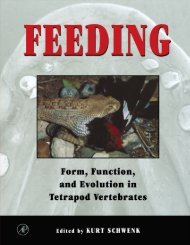The minimum equipment necessary to collect insects consists
The minimum equipment necessary to collect insects consists
The minimum equipment necessary to collect insects consists
You also want an ePaper? Increase the reach of your titles
YUMPU automatically turns print PDFs into web optimized ePapers that Google loves.
IO<br />
COLLECTING EQUIPMENT<br />
in<strong>to</strong> a vial or other container' This container has intake and mouthpipcL<br />
tub* , nlerinq it: lhc inlal. lubP i" u.urlll a piece o[ ra in<br />
elas" rubina xbout n ir. lone, and the moulhll'ce luue IS ri.ll'<br />
!las- rubirf lhrough l]re cork plu' I r2 lo 2 'l (r1 rubber lubrrg,<br />
ivirh a pl"ti.f clo-th over Ihe inner cnd lo nrevc'l ir'r'r-t" from<br />
beinc sucked inlo lhc rnoulh llac' ll-e cnd of the Inlake lube<br />
close-<strong>to</strong> the insect and suck through the mouthpiece. An asplra<strong>to</strong>r<br />
is u.eltl for collrctirrg.mall, nut loo sLlir, ir:e(ls. eilh'I lrom a'l<br />
in"ect net. a Dldll. o'r rnolher 5ilualion <strong>The</strong> in:cct' coll cte'l<br />
"o<br />
mav Le leDl ilire nr lrarr"ferr.d ro r, killine jar.<br />
Traps. in",,t trdp: can Le ron5lrur ted in r'rriou'r3)s alld Ihe<br />
attraiiarl u",J wili ,l,termir. rhr t;pe" of irr'eLr" likely <strong>to</strong> be<br />
caught. Tn" irltraclanl rraJ Lc crlifrcirl lieht. decar''rg m''at or<br />
fruii, or orher thing.. Trre lrapr ar.,on:lructed :o Ilri'tt on't thc<br />
in.".,. o.t in rh.r iannol gel oul somc lrapc cu'h a' 1fo'e wilh<br />
liitlrt r"'thc allr;crant) mav bc con'trucled Io direcl lhe cauehl<br />
in_sects cvcntuallv in<strong>to</strong> a coltaiDcr o[ alcohol or a killing jar;others<br />
t'rift t* n" ft.''r".1 u irh d"..rl ing ll.aterial' ) Inav hc cun5l ru( ted<br />
lo dirccr<br />
". lhe in.rct. inrn i:p,cial , ha.1bcf and .lol inlo lhc Lrarl'<br />
lc.eLr" artracte'l ru lighri o bait. mry ofttr be 'ollntcd by<br />
hand or rvith a nP , $il\ou1 use o[ a tr.rp lnscct'allracl'Ll lo a<br />
lieht. for , xarnple, cd'r L,, collecr' Ll dir''' tr) int''' a krllrrr{ J€r or<br />
oiher cor'trin,r shpn rhey alight nn .orn, 'ulracr' ne.rrby (a.l ghl<br />
colore,t t"oll ot sheet). Tirus jiou can collcct only those specirnens<br />
in nh:rh r'ou rr. Da-licularly irtere.ted<br />
Aquatii Collect'ing Equipment. \4ary aluat ic ir'c' ls can be<br />
collcired hr hen.1 oi uir\ forc.ps fron obje,ls in lhc \\'dier: moll<br />
car L-,c.ollecled $itlr a nel oroilrer oLrire. A' aqudli' rel'hould<br />
br much lhalr un a,ricl nel,Milhabagno'leep(r ll'an ll'P<br />
"turditr<br />
diameter of the rim. Kitchen straincrs i[ <strong>to</strong> 6 in. in diameter make<br />
good dip nets.<br />
ii" i;o-""' or .trainrr c.n.s up full ol mud ar.l debri', rhe<br />
lnsects ,".s tul.n may m 'v bc b, tlifhcult .lifficult <strong>to</strong> .e,lunl".-<br />
sei unless they lhPy n-o\e move. To locale locate<br />
them. dump the net contents in<strong>to</strong> a white bot<strong>to</strong>med pan of water'<br />
Insecis arc'easily secn against this $hite backgrolnd, and.can.be<br />
i"""'",i rru l'r,ia, Ior."i., o- ey,tl'opp' r' Siall rree-srvrmming<br />
forms Io,m. likc li<strong>to</strong> mosqui<strong>to</strong> mo* rrilo larvac ir\ac are best bert colrPcled $ilh a lonJ fandlPd<br />
rvhite ivhite enameled dipPer, dipper, in which the <strong>insects</strong> similarly sholv up<br />
lvell. ll. Rcmove thcm with an eyedropper'<br />
Otf"i equip-"nt aod M(th;ds. Mrny ir.c,.ts crn be colleclrd<br />
dir.ctlt<br />
'ccrlr irrLo inro a k:llinc k:lling j.rr irr or olhe' colrlrilPr,<br />
colrlrilPr' \lthoLt \lthoLt.lhe lhe ur' u"' ol a<br />
nrt. Thi. i. thL -imllc-t uay lo collec in"e.l thxi arlgff oll a lal<br />
.uitr." u' a do r ut fly loo i,adiry. an'l mar) in5'cr' or llo*er''<br />
Various trpe' o' buildirg. ofltl 'ervL 3' in5e(l lraps: ln'ecl'. l'y<br />
in and aliglrt on lle !!xllc or criling and r'nai1 lher'. or they<br />
uiighfon -lvinaoru. - lrom which they can be <strong>collect</strong>ed dircctly<br />
in<strong>to</strong> a iar.<br />
A hJavy knife is uselul lor cutting in<strong>to</strong> logs or branchcs, opcning<br />
MOUNTING AND PRESERVING INSECTS<br />
galls, prying up bark, or tligging in<strong>to</strong> places that may harbor<br />
<strong>insects</strong>. Keep at hand a notebook and pencil for taking notes, and<br />
rrake triangular paper pr ve'opes lrom tlre rrot,book page..<br />
Collecting some kinds of <strong>insects</strong> requires special <strong>equipment</strong> not<br />
mentioned above. An ingenious collec<strong>to</strong>r should be able <strong>to</strong> devise<br />
<strong>equipment</strong> and procedures for <strong>collect</strong>ing such <strong>insects</strong>.<br />
Mounting and Preserving Insects<br />
Most <strong>insects</strong> are prcserved dry, normally on pinsr and once dry<br />
will keep indcfinitely. Soft-bodied <strong>insects</strong> must be preserved in<br />
liquids, sincc they shrivel or become dis<strong>to</strong>rted if preseNed dry.<br />
Minute <strong>insects</strong> that are hard bodied may be mounted (dry) on<br />
"points," but many must bc mounted on microscope slides for<br />
detailed study. lnsects that are prcserved dry shouki be pinned<br />
or mounted as soon as possible after they are <strong>collect</strong>ed;if allowed<br />
<strong>to</strong> dry first they.become very brittle and may be broken in the<br />
process ot mounarng.<br />
Relaxing SpecimeEs. l)ried specimens can be relaxed by placing<br />
them in a humid atmosphere lor a fcw dayslany ai.tight jar can<br />
be used as a relaxing chamber. Cover the bot<strong>to</strong>m of the jar with<br />
wet sand (add phenol or ethyl acetate <strong>to</strong> prevent mold), put the<br />
<strong>insects</strong> iD<strong>to</strong> the jar in small open boxes or envelopesJ and close<br />
rne lar.<br />
Pirming. Insccts suf[ciently ]rard bodied <strong>to</strong> retain thcir shape<br />
whcn dry, and big enough <strong>to</strong> pin, are normally preserved by pinning.<br />
Common pins are <strong>to</strong>o thick and <strong>to</strong>o short, and they rust;<br />
<strong>insects</strong> should be pinned with i.rtsecl Piirs, made especially lor this<br />
purpose, which can be bought from a supply house. <strong>The</strong>y are<br />
available in various sizes (thicknesses). <strong>The</strong> best sizes Ior gcneral<br />
use are Nos. 1 (vcry slcndcr), 2 (less slender), and 3 (thicker, for<br />
larger insccts).<br />
Most <strong>insects</strong> are pinned vertically through the thorax; a Ielv<br />
are pinncd sidet'ays. Bcetles and hoppers are pinned through the<br />
Iront part of the right wing, at a point lvhcre the pin on emerging<br />
from the underside ol the body will not damage a leg. Bugs are<br />
pinned through the scutellum (p. 33) if it is large enough <strong>to</strong> take<br />
a pin or through the right rving, as for beetlcs. Grasshoppers and<br />
crichets are pinned through the rear edge oI the pronotum, just <strong>to</strong><br />
the right of the nlidlille. A tleehopper is pinned through the pronotum<br />
just <strong>to</strong> the dght of the midlinc. Dragonflies and damselflies can<br />
be pinned vertically through thc thorax ivith the wings horizontal,<br />
but it is better <strong>to</strong> pin thcm sidervays, lelt side up, rvith the wings<br />
<strong>to</strong>gether abovc the body, the pin going through the thorax below<br />
the wing bases. If the rvings are not <strong>to</strong>gethcr rvhen the specimen<br />
is removed Irom the kiliing jar, place the spccimen in an envelope<br />
(the wings <strong>to</strong>gether above the body) for a day or t$.o until it has<br />
dried enough for the wings <strong>to</strong> stay in this position; then pin it.<br />
II



